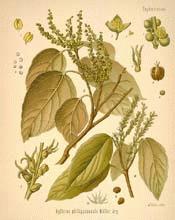
Botanical.com Home Page

|
Kamala
(Mallotus philippinensis)
Click on graphic for larger image
|
Kamala
Botanical: Mallotus Philippinensis (MUELL.)
Family: N.O. Euphorbiaceae
---Synonyms---Glandulae Rottelerae. Kamcela. Spoonwood. Röttlera tinctoria.
---Parts Used---Glands and hairs covering the fruits.
---Habitat---India, at the foot of the Madras hills, Malay Archipelago, Orissa, Bengal, Bombay, Abyssinia, Southern Arabia, China, Australia.
---Description---A very common small Indian tree, named after the Rev. Dr. Röttler, the naturalist, who died in 1836. It is 20 to 30 feet high, trunk 3 or 4 feet in diameter, branches slender with pale bark, the younger ones covered with dense ferruginous tomentosum; leaves alternate, articulate petioles, 1 to 2 inches long; rusty tomentose, blade 3 to 6 inches long, ovate with two obscure glands at base, entire, coriaceous, upper surface glabrous, veins very prominent on under surface, flowers dioecious. Males three together in the axils of small bracts arranged in longer much-branched axillary branches to the females, both densely covered with ferrugineous tomentosum, flowering November to January. From the surface of the trilobed capsules of the plant, which are about the size of peas, a red mealy powder is obtained; this consists of minute glands and hairs coloured brick or madder red, nearly odourless and tasteless; it is much used by the Hindu silk dyers, who obtain from it by boiling in carbonate of soda, a durable flame colour of great beauty. The capsules are ripe February and March, when the red powder is brushed off and collected for sale; no other preparation is necessary to preserve it.
---Constituents---Rottlerin, yellow and red resins, wax, and a yellow crystalline substance, tannic acid, gum, and volatile oil.
[Top]
---Medicinal Action and Uses---The root of the tree is used in dyeing, and for cutaneous eruptions, also used by the Arabs internally for leprosy and in solution to remove freckles and pustules. In this country it has been successfully used for an eruption in children known as wildfire, the powder is rubbed over the affected part with moist lint. Its greatest use, however, is in the use of tapeworm, being safer and more certain than other cures; the worm is passed whole and generally dead. The dose of Karmala for a robust person is 3 drachms, but only half that quantity for anyone of enfeebled health; the fluid extract is milder and acts with more certainty.
Kamala acts quickly and actively as a purgative, and often causes much griping and nausea, but seldom vomiting. It may be given in water mucilage or syrup; the worm is usually expelled at the third or fourth stool; if it fails to act, the dose is repeated after four hours, or a dose of castor oil is given. Kamala is largely used in India externally for cutaneous troubles, and is most effective for scabies. It has been successfully employed in herpetic ringworm (a disease very prevalent there), and as a taenifuge it has been used with good results, on the Continent, combined with Kousso and known as Kama-kosin.
Kamala is insoluble in cold water and boiling water has little effect on it. The resin is the most active constituent, and is dissolved by ether, chloroform, alcohol or benzol. When exposed to a flame it explodes with a flash resembling Lycopodium.
---Preparations and Dosages---Powdered Kamala, 2 to 4 drachms. Fluid extract, 2 to 4 drachms.
---Adulterations---Kamala is often grossly adulterated; its quality can be judged by throwing a little on the surface of water, when the adulterants, such as sand, ferric oxide, etc., will sink, and the pure drug float; stalks and leaves can be easily sifted out. Dyed starch is detected by microscope, also ground safflower by same means.
---Other Species---(N.O. Leguminosae.)
Flemingia congesta, under the name of wurrus (contains a substance similar to Kamala), is a large shrub growing in India and Africa, gives a dull dark purplish powder and consists of single not grouped hairs and glands, the glands being in tiers not radiating; wurrus contains two resins, one dark and the other orange brown, an orange red crystalline substance, flemingin and homoflemingin, principles which while resembling Kamala are not identical with it, but largely used in India as a dye, giving silk a lovely golden colour.
Rottlera Schimfeeri, the bark of which has anthelmintic properties.
[Top]
Common Name Index
A MODERN HERBAL Home Page
Bear in mind "A Modern Herbal" was written with the conventional wisdom of the early 1900's. This should be taken into account as some of the information may now be considered inaccurate, or not in accordance with modern medicine.
© Copyright Protected 1995-2025 Botanical.com
|

